
Subtitles & vocabulary
One reason why coronavirus hits black people the hardest
00
林宜悉 posted on 2020/07/28Save
Video vocabulary
access
US /ˈæksɛs/
・
UK /'ækses/
- Noun (Countable/Uncountable)
- Way to enter a place, e.g. a station or stadium
- The opportunity or right to use something or to see someone.
- Transitive Verb
- To be able to use or have permission to use
A2TOEIC
More severe
US /səˈvɪr/
・
UK /sɪ'vɪə(r)/
- Adjective
- Very bad; harsh
- (Of clothes, etc.) plain; simple; not decorated
A2TOEIC
More poverty
US /ˈpɑvəti/
・
UK /ˈpɔvəti/
- Uncountable Noun
- State of being poor
- Lack of something necessary
B1
More exposure
US /ɪkˈspoʒɚ/
・
UK /ɪk'spəʊʒə(r)/
- Noun
- Allowing light through a cameras lens onto film
- Being talked about in the media
A2TOEIC
More Use Energy
Unlock All Vocabulary
Unlock pronunciation, explanations, and filters
